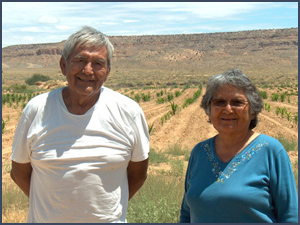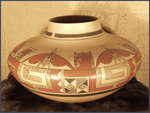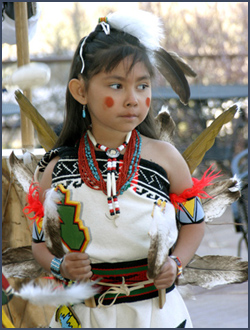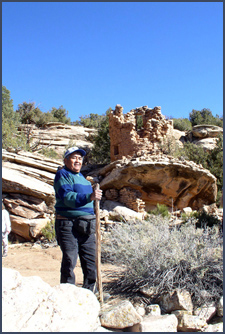Peoples of the Mesa Verde Region
Today: Mid-1900s to the PresentPueblo
Although Pueblo people, as a group, no longer live in the Mesa Verde region, their presence is still felt through the remarkable material legacy their ancestors left behind. From towering masonry walls to scattered pottery sherds and distinctive art carved into sheer rock faces, the ancestral Pueblo people left their mark on the landscape for all who followed to see. 
Hopi tribal members Eric and Jane Polingyouma at their farm near Kykotsmovi, Arizona. Eric is a rancher, farmer, and respected elder; Jane is a retired schoolteacher and principal. (See enlarged photograph.) Today, however, more than 60,000 Pueblo people live in 32 Pueblo communities in New Mexico and Arizona and one pueblo in Texas. As farmers, educators, artists, business people, and civic leaders, Pueblo people contribute not only to their home communities but to broader American society as a whole. Many are bi- or trilingual, speaking English and sometimes Spanish in addition to one of the six different Pueblo languages—Tewa, Tiwa, Towa, Keres, Zuñi, and Hopi. In addition to keeping their languages alive, the Pueblo people have also maintained their own customs and government—an inspiring testament to their enduring spirit and strong sense of Pueblo identity. 
Contemporary Hopi pottery vessel, created by Miriam Nampeyo, member of the renowned family of potters. (See enlarged photograph.) A very important part of Pueblo peoples' identity is their strong spiritual connection to the Mesa Verde region. Some make pilgrimages to the region for religious purposes and to visit their ancestors, who they believe still dwell in ancestral Pueblo sites. It is important for archaeologists and other people who study or visit these sites to understand and respect Pueblo peoples' continuing sense of connection to these special places. Watch the award-winning video Visit With Respect, in which Pueblo Indians talk about how they feel about archaeological sites and the importance of treating sites with respect (length: 9:30). Bringing the ancestors home: Read about the Native American Graves Protection and Repatriation Act. Visit the official Web sites of the pueblos.
|
||
Acknowledgments | Illustration credits | To borrow, cite, or request permission | Please take our survey! Title page for Peoples of the Mesa Verde Region |
||
 DONATE TODAY
DONATE TODAY


